Children win battle over Thalassaemia
By Carol Aloysius
Thalassaemia. It is a word that conjures up dreadful images in the
minds of both parents and children suffering from this blood disorder
that causes chronic anaemia. The carriers are not strangers to the
victims. They are in fact their own parents whose marriages have been to
close relatives (consanguineous marriages), usually first cousins -
marriages which medical experts describe as 'unhealthy unions' since
they cause not only Thalassaemia, but a host of other life long health
disorders, including congenital disorders.
|
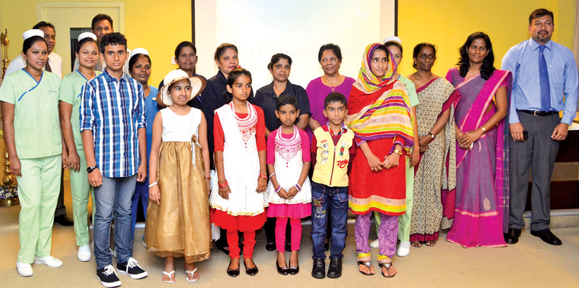
The dedicated nursing staff, doctors of the Bone Marrow
Transplant and Clinical Haematology Unit with the patients
and donors. |
Children diagnosed with Thalassaemia require monthly blood
transfusion with treatment starting as early as six months after birth
and continuing for the rest of their lives. In addition, they require
iron chelation which is injections, 5-6 times per week and /or a, oral
medication daily for life.
Failure to receive this multiple combination of treatments could
result in their lives being cut short at a very early stage.
Yet, undergoing this life saving treatment for the rest of their
lives can be a traumatic experience for anyone, especially a young
child.
The only alternative which could end this daily nightmare would be to
have a bone marrow transplant (BMT). Until two years ago, only parents
who could afford to obtain treatment for their sick children were able
to go abroad for bone marrow transplant.
Today, thanks to the pioneering efforts of the management of the
Central Hospital, BMT is now no longer the dream of children hoping to
end their life long nightmare of regular blood transfusions and painful
injections plus oral medications they hate to take.
In June 2013, with the official opening of the Bone Marrow Transplant
and Clinical Haemotology Unit by the former Health Minister, now
President Maithripala Sirisena, for the first time in Sri Lanka this
advanced treatment is now available at an affordable price to all
patients of thalassaemia and other related disorders.
What is more, the hospital authorities went a step further to select
19 children from deserving families who urgently required BT to save
their lives, and treat them free of charge waiving the large sum of
money which the procedure could cost them.
Of the patients who were treated successfully, the media, on
Wednesday, had the opportunity of meeting three of them who shared their
stories with us.
Each of them we soon found were intrepid little fighters eager to
move on now that they were able to put the past behind them. And in each
case, the donor had been either a sister or a brother.
|
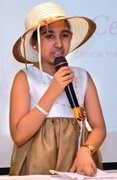
Charuni Apsara - patient |

Brother Akila - donor
|
Take Mohamad Rizvi 7, the first patient to undergo BMT. He was just
five months old when his parents who hail from Bingiriya realised that
all was not well with their only son.
"He wasn't moving actively and refused to take his feeds. After
taking him to the provincial hospital at Bingiriya, we were told to go
to the Ruhuna Hospital where he was diagnosed as having Thalassaemia.
After that it was a case of daily trips to the Ruhuna which we could ill
afford. But we went nevertheless", his father S.U.Y. Riwadeen told the
Sunday Observer.
Thalassaemia Circle
Meanwhile, parents of children with Thalassaemia had taken their own
initiative to form a Thalassaemia Circle which enabled them to share
their knowledge, information and latest updates about the diseases, and
thereby draw comfort from such shared experiences.
"One of the best things that happened as a result of joining this
Circle, was news of a special unit to treat such children with Bone
Marrow transplant in our own country, at the Central Hospital in
Colombo", his father S.U.Y. Riwadeen recalled. "After contacting them we
were told to come there bringing a donor with us. So I took my daughter
Fathima Madida 11, who is his older sister, and after doing several
tests on her they found she had a 100 percent match. We were all
delighted especially Mohamed, who was waiting impatiently for the new
treatment, where he would be the first patient."
Young Mohamad underwent his trail blazing treatment without many
problems. Its successful outcome spurred the doctors and hospital
authorities on with their life saving operations undaunted by the
challenges that could lie ahead of them. By now the demand for BT was
steadily growing.
Today, young Mohamed enjoys a carefree life, cycling, running and
playing games like any other boy, and plans to be a policeman when he
grows up.
Thasuni Himansa is also seven years. Like Mohamed, the donor for the
matching bone marrow came from her sister Thathsara Thejani aged 10
years. Parents Sisira Bandara and Inoka recalled the exhausting and
fearful days when their five month once active baby suddenly refused to
be fed and became listless and wan.
"We were directed to the Kurunegala Hospital after our doctor at the
Hiripitiya Hospital diagnosed her as having Thalassaemia. When we rushed
her there her blood count had plunged to 4.5, far below the normal 'low'
count of 8. After being given her first blood transfusion, we registered
at the National Thalassaemai Centre at Kurunegala and from then on it
was a case of journeying back and forth." Unable to bear the sight of
their child suffering with so many transfusions and injections, they
began looking for options.
"I heard about Bone Marrow Transplants being done abroad but the cost
was prohibitive. I went to Cyprus to earn enough money to take my
daughter for this procedure", Sisira said.
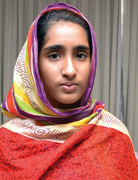
Sister Fathima - donor |
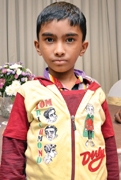
Mohamed Rizwi - patient |
Fortunately by now the Central Hospital had opened its new unit and
the parents were informed of it by Dr Kalinga Nanayakkara who was
treating their child. "It was he who contacted Dr Lawrence, an Italian
specialist who then flew down to Sri Lanka to do this procedure. My
daughter was the second on the list".
Thasuni is a grade 6 student at the Hunupota MV. Her mother proudly
informed us she was a scholarship winner. "My favourite subject is Maths.
But what I really would like to be is a doctor or a nurse who can treat
children like myself", she said confidently.
Charuni Apsara, at 13 is the oldest of the trio.
The young teenager was barely nine months when she first began
undergoing treatment at the Kandy Hospital. Like the previous two
patients, she too received her life saving marrow from her sibling - her
older and only brother Akila Desha. The latter, who was put under
anaesthesia prior to the operation cannot recall anything of the
procedure, but said he was impatiently waiting for his bed ticket to be
cut three days later so he could visit his sister, still in the ICU
recovering.
Charuni developed GVD (Graft versus Host disease) and a CMV virus due
to her immunity going down during the procedure. "We nearly lost her but
thanks to our very dedicated team of doctors and nurses, and the
extremely sterile ICU room where this treatment is carried out, she
pulled through and recovered sooner than we expected", Sister - in
charge- Mahawatthe said.
"We never thought she would make it that fateful day. So we are
eternally grateful to the doctors at Central Hospital for performing
this miracle. We consider them as her saviours", her mother Inoka said
in an emotionally charged speech at the end of a lavish ceremony hosted
by the hospital, complete with gifts and a specially baked cake for the
children. Charuni, wearing a bonnet and beige dress, and looking like a
little princess from a fairy tale speaking on behalf of the three
patients echoed her mother's sentiments, later telling me she hoped to
be a radio announcer, "now that I have got this experience of speaking
in public".
To the Head of the Unit Thelani Weerasinghe, accepting the offer made
by the hospital to set up its first BMT Centre was a "challenge I
couldn't resist. I was honoured and deeply privileged to be working with
such a dedicated team." Using her experiences gleaned abroad in New
Zealand and Australia, she set about training the nursing staff. "As you
know over 90 percent of infection control is due to good nursing.
I have only six nurses all from the ICU and all of them handpicked,
100 percent committed and dedicated.
They are willing to work in shifts and break rest to ensure their
patients get high quality care. I'm lucky to be able to work with them -
and the doctors", she said. "We treat both the patient and parents who
need counselling. Our hotline is available to them from any part of the
island 24 hours of the day."
|
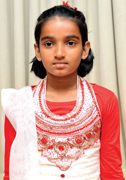
Sister Thathsara - donor |
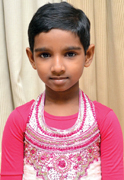
Thasuni - patient |
Honorary Consultant Haemotologist Dr Lalindra Goonewardene citing
statistics said that although the first BMT was performed half a century
ago, and many thousands done abroad, this was the first instance when
this procedure was being made available in Sri Lanka. "BMT is the only
curative option for many blood disorders such as leukemia, thalassaemia
and bone marrow failure", he noted. He said BMT was no longer in its
experimental stage here, with the numbers of patients increasing daily.
"So far we have had between 50-100 who have benefited using allogenic
donors (close relatives).
Consultant Paediatrician Dr Ruwanthi Dissanayake said a survey by the
Health Ministry in 2011 had found 1,547 thalassaemia patients islandwide.
"But these figures may be much more as many would have died before even
being diagnosed", she said. She said between 6 - 80 children were born
every year with the disease.
"The cost is around Rs 500,000 each year and if the patient lives to
40 years it could zoom to 20 million, all of which is government
expenditure. Hence the Health Ministry is currently carrying out a
National Thalassaemia Prevention Program screening couples on the
threshold of marriage on a voluntary basis and giving them free advice",
she said.
As for the three youngsters, their dreams of the future are now
filled with the promise of enjoying their childhood to its fullest
potential. |

